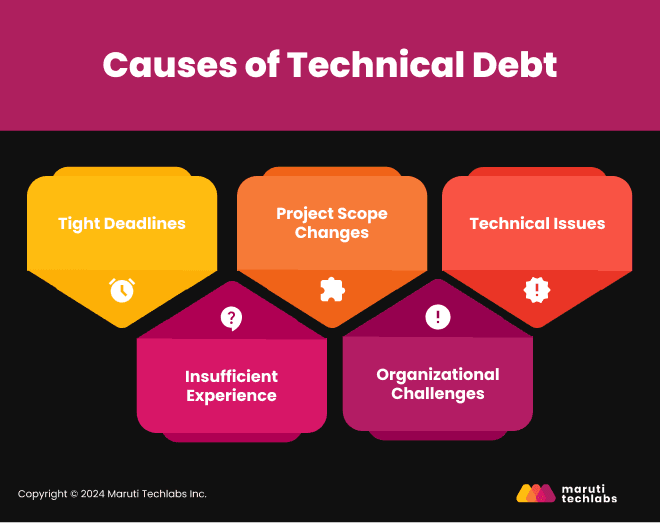

How to Handle the Hidden Costs of Technical Debt






Rushed code comes with hidden costs. It slows progress, increases expenses, and creates unnecessary complexity. Over time, it slows progress, increases costs, and makes systems harder to manage when it matters most.
When software updates take too long, or teams spend more time fixing bugs than innovating, it’s often a sign of technical debt. These can turn off even the most ambitious projects. However, the good news is it doesn’t have to stay this way.
In this article, we’ll explore the true cost of technical debt—how it affects your business, your team, and your bottom line. More importantly, we’ll give you actionable strategies to identify, address, and minimize it. Ready to take back control of your codebase? Let’s dive in.
Technical debt is the cost of cutting corners in software development. It accumulates when businesses rush to meet deadlines or satisfy immediate needs and opt for quick fixes instead of robust, future-proof solutions.
At first, technical debt seems harmless, like borrowing money to buy something essential. But just like financial debt, it comes with interest: slower performance, higher maintenance costs, and even missed opportunities.
For example, a codebase filled with outdated code can create cascading issues. Fixing one bug triggers three new topics, and what should’ve been a simple upgrade now takes weeks. That’s technical debt in action, quietly eroding productivity and innovation.
Beyond the surface, technical debt hampers efficiency, delays updates, and poses security risks. Businesses struggle to meet client demands, and over time, the costs of maintaining these band-aid solutions far outweigh the benefits of speedy delivery.
But why does it happen? Let’s explore what drives businesses to accumulate this costly burden.
Technical debt doesn’t happen overnight. It develops when processes are incomplete, decisions are rushed, or resources are insufficient. Pushing for quick delivery or meeting deadlines can spark innovation, but it often comes at the expense of long-term stability.

Here’s how it unfolds.
Understanding what causes technical debt is the first step to tackling it. However, to effectively manage it, we must explore its different forms and how they impact your business.
Let’s look at the types of technical debt.
Not all technical debt is created equal. It comes in various forms, depending on how it originates and what areas it affects.

Understanding these types is crucial for effectively identifying and addressing the root causes.
When teams intentionally take shortcuts to meet deadlines or accomplish short-term objectives, intentional debt results. For instance, skipping comprehensive testing to launch a product faster is a calculated risk. While it might work in the short run, it often leads to complications down the line.
Unintentional debt arises from oversight or lack of knowledge. For example, a developer might use outdated technology without realizing it. This can lead to poor solutions that require significant rework later. It’s a common issue in teams without proper training or transparent processes.
While understanding the types of technical debt is essential, it’s equally critical to recognize how they impact your business in the long run.
Ignoring technical debt leads to consequences that extend beyond codebases, affecting teams, customers, and business growth. It’s not just a technical problem but a strategic challenge demanding attention.
Technical debt frequently leads to malfunctions, poor performance, or system outages. These issues frustrate users, damage your brand’s reputation, and drive customers to competitors. For example, an e-commerce platform with frequent crashes during sales events risks losing both customers and revenue.

Innovation takes a back seat when teams are bogged down with maintaining fragile systems. Constant firefighting delays new feature development and inflates costs. Over time, this repetitive cycle leads to developer burnout and high attrition rates.
As technical debt accumulates, systems become harder to update or scale. Outdated infrastructure limits your ability to support new features or handle increased traffic. This slows your ability to adapt to market demands, putting your business at risk of falling behind competitors.
Addressing technical debt guarantees the long-term viability of your company and entails more than merely improving code. Here’s why it matters:
Ignoring technical debt jeopardizes scalability and competitiveness. By resolving it proactively, businesses can position themselves for sustained growth and market leadership.
Strategic debt management guarantees quicker delivery without compromising stability. This strategy keeps a strong basis for the future while encouraging innovation.
Debt reduction planning integrates technical goals with more general corporate plans. Without frequent failures, it enables teams to produce solutions that promote creativity and productivity.
After understanding the impacts and importance of addressing this technical issue, we must use practical methods to control and lower it efficiently.
Technical debt may seem daunting, but with the right strategies, it’s entirely manageable. By adopting proactive measures, businesses can ensure long-term scalability and stability.

Regular code review ensures that issues are caught early, reducing the chance of long-term problems. Automated testing adds another layer of assurance by identifying bugs and inefficiencies before deployment. For example, teams using platforms like GitHub Actions for automated tests have seen a significant drop in post-deployment bugs.
Over time, codebases become bloated with patches and workarounds. Refactoring outdated code improves maintainability and ensures systems remain flexible for future updates. Consider how Netflix continuously refactors its platform to support seamless streaming across new devices and markets.
Managing technical debt should not be a separate activity. Aligning it with broader business objectives ensures that teams prioritize the most impactful areas. For instance, if scalability is a key goal, addressing infrastructure debt becomes a top priority.
Addressing technical debt requires a proactive approach, but ignoring it can have significant consequences. Let’s examine actual cases of firms affected by unmanaged technical debt.
Even the most promising companies have failed due to unmanaged technical debt. The following are two striking examples:
Once a social media giant, Myspace fell victim to outdated infrastructure and an inability to scale. The platform became lethargic as technical debt piled up and user experience suffered. This gave competitors like Facebook the edge to overtake the market.
Nokia’s failure to modernize its software ecosystem is another cautionary tale. Despite its limitations, the company’s decision to continue with its existing operating system, Symbian, became a significant hindrance. This accumulated technical debt hindered the company’s ability to innovate, making it difficult to adapt to the rapidly changing market, leading to its decline.
Technical debt doesn’t have to be a roadblock. When managed strategically, it can be an opportunity to refine systems, enhance innovation, and future-proof your business. Businesses can turn technical debt from a problem into a development engine by implementing contemporary tools and procedures, integrating frequent assessments, and coordinating debt management with corporate objectives.
Remember, the cost of ignoring technical debt is far greater than the effort required to address it. It’s not about eliminating debt entirely—it’s about managing it smartly to ensure your systems are agile, secure, and ready for the future.
Struggling with the impact of technical debt on your business? Maruti Techlabs is here to help you tackle it head-on. From modernizing legacy systems to streamlining codebases and implementing scalable software solutions, we ensure your systems are prepared for the challenges of tomorrow. Don’t let technical debt hold you back—reach out today, and let’s create a roadmap to transform your systems into a competitive advantage.
Not entirely. Technical debt is a natural byproduct of innovation and rapid development. The key is effectively managing it by balancing short-term goals with long-term sustainability.
Start with regular code audits, performance assessments, and feedback from your development team. Using automated testing tools can also help uncover inefficiencies.
Poor coding practices are inadvertent mistakes or inefficiencies, whereas technical debt frequently entails deliberate trade-offs for speed. Both can produce long-term concerns but require different techniques to treat.
Yes, because they have fewer resources, small enterprises are frequently more affected by technical debt. Strategic debt management, however, can keep debt from impeding development.
Foster open communication, provide training, and set clear guidelines for prioritizing and addressing debt. Regular team meetings and retrospectives can also help maintain focus.


